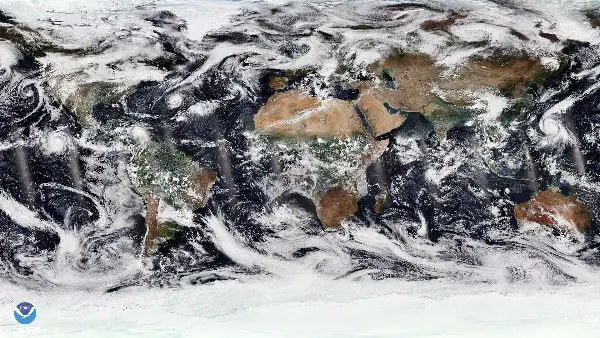May 11 2022
This afternoon I received an email from NOAA about surprising research in the realm of air pollution and tropical cyclones. This is a Press Release that is bound to spark conversation and perhaps even some controversy as any talk about the environment is often met with passion.
I want to share this with you in its entirely below. But the simple take away is this:
Less pollution in the Northern Hemisphere resulted in MORE Tropical Storms and Hurricanes in the Atlantic.
Air pollution in North American and Europe is estimated to have dropped 50% from 1980 to 2020. That is believed to have led to warmer ocean surface temperatures.
The revers was found in Asia, where increased pollution led to fewer tropical cyclones over the Northwest Pacific.
I know, it sounds wild, and I believe the researchers were surprised as well. This is by no means a suggestion to let air pollution run out of control again to calm the tropics. I fast, there is more to it I would like to share. But note: the title in my article is very similar (just shorter) to how they presented this.
Here is the report as I received it, along with an additional video embedded here for easy access.
Study: Reducing air pollution in North America & Europe brings unexpected result: more hurricanes
Research also finds increased pollution in Asia reduces tropical cyclones
Contact
Monica Allen, [email protected], 202-379-6693
May 11, 2022
A new NOAA study published today in the journal Science Advances about four decades of tropical cyclones reveals the surprising result that reducing particulate air pollution in Europe and North America has contributed to an increase in the number of tropical cyclones in the North Atlantic basin and a decrease in the number of these storms in the Southern Hemisphere. The study also found that the growth of particulate pollution in Asia has contributed to fewer tropical cyclones in the western North Pacific basin.
“Air pollution is a big environmental risk to human health and we have made great strides in reducing health risks by reducing particulate air pollution,” said Hiroyuki Murakami, a physical scientist at NOAA’s Geophysical Fluid Dynamics Laboratory and study author. “But reducing air pollution does not always decrease the risk of hazards from tropical cyclones.”

A daylight composite of Earth from Aug. 29, 2021 as seen by the NOAA-20 Satellite. In this image, Hurricane Ida can be seen making landfall on the U.S. Gulf Coast while Hurricane Nora spins in the eastern Pacific Ocean. Credit: NOAA
While a number of recent studies have examined how increasing greenhouse gas emissions are impacting global tropical cyclone activity, Murakami tackles the less studied and highly complex area of how particulate pollution in combination with climate changes is affecting tropical cyclones in different areas of the planet. Murakami reaches these conclusions using the state-of-the-art climate model developed at NOAA GFDL.
How does less pollution in the Northern Hemisphere increase tropical storms in the Atlantic?
Over the last 40 years, Europe and North America have been leaders in reducing particulate air pollution from industry, autos, energy and other sources. The increasing absence of human-caused air pollution in the Northern Hemisphere, estimated to be a 50-percent drop in concentration from 1980 to 2020, has led to surface warming over the tropical Atlantic Ocean, which contributes to more frequent tropical cyclones. Without significant amounts of particulate pollution to reflect sunlight, the ocean absorbs more heat and warms faster. A warming Atlantic Ocean has been a key ingredient to a 33-percent increase in the number of tropical cyclones during this 40-year period, Murakami said.
The decrease in pollution has also led to a warming of the mid- and high-latitudes in the Northern Hemisphere. This warming of land and ocean is causing the steady poleward movement of the jet stream from the tropics toward the Arctic. The shift of the jet stream led to weakening westerly winds in the upper troposphere in the tropical Atlantic basin, an area of the atmosphere about 10 to 12 miles from the surface of the earth. Weaker winds, in turn, mean that there is less difference between the speed of winds in the lower and upper troposphere or less wind shear. With little wind shear, tropical cyclones are able to develop and grow in strength over the Atlantic Ocean.
How does more pollution in Asia reduce tropical storms in the western North Pacific?
The earth system processes at work in the western North Pacific – an area where strong tropical cyclones are called typhoons – are the flip side of what’s happening in the Atlantic basin. The key ingredient for the decrease of tropical cyclones in the western North Pacific is also air pollution, according to the new research. In this case, a 40-percent increase in the concentration of particulate air pollution has been one of several factors that has contributed to a 14-percent decrease in tropical cyclones, Murakami said. Other factors include natural variability and increased greenhouse gases.
Over the western North Pacific Ocean, increasing air pollution from the rapidly developing economies of China and India have reduced the strength of the Indian monsoon winds in the summer. The increased pollution is cooling the land in East Asia, serving to reduce the difference between the temperature of the land and the ocean. Without this contrast in temperature, monsoon winds become weaker. In general, tropical cyclones in Asia are born in the summer in what is called the monsoon trough, which is where westerly Indian monsoon winds converge with trade winds in the western Pacific Ocean. With weaker monsoon winds there are fewer tropical cyclones.
How does reduced pollution in the Northern hemisphere lead to fewer tropical cyclones in the Southern Hemisphere?
The warming trend in the mid- and high-latitudes of the Northern Hemisphere has been changing largescale global circulation patterns, said Murakami. These changes have led to increased upward air flow in the Northern Hemisphere. This is causing a downward air flow in the Southern Hemisphere. This downward air flow comes with high pressure, which inhibits the formation of tropical cyclones.
What is the implication of the new research?
“This study indicates that decreasing air pollution leads to an increased risk of tropical cyclones, which is happening in the North Atlantic, and could also happen, if air pollution is rapidly reduced, in Asia,” said Murakami. “The ironic result suggests the necessity of careful policy decision-making in the future that considers the pros and cons of the multiple impacts.”
Murakami added that the projection for the next decades is that human-caused particulate air pollution will remain stable in the North Atlantic and that increased greenhouse gases will become a more significant influence on tropical cyclones. The projection is for fewer numbers of tropical cyclones, but those that occur are likely to be more intense.
For more information:
Video
Also see the full report here: NOAA Geophysical Fluid Dynamics Laboratory Highlight
Go online to read the research in Science Advances, “Substantial global influence of anthropogenic aerosols on tropical cyclones over the past 40 years.”
Tropical Season Begins June 1
Related Posts
Atlantic Tropical History: Maps of Origin Regions Every 10 Days
Weather posts straight to your inbox
Sign up and be the first to know!
Please share your thoughts, best weather pics/video, or just keep in touch via social media
Facebook: Justin Berk, Meteorologist
Twitter: @JustinWeather
Instagram: justinweather
*Disclaimer due to frequent questions:
I am aware there are some spelling and grammar typos. I have made a few public statements over the years, but if you are new here you may have missed it:
I have dyslexia, and found out at my second year at Cornell. I didn’t stop me from getting my meteorology degree, and being first to get the AMS CBM in the Baltimore/Washington region.
I do miss my mistakes in my own proofreading. The autocorrect spell check on my computer sometimes does an injustice to make it worse.
All of the maps and information are accurate. The ‘wordy’ stuff can get sticky.
There is no editor that can check my work when I need it and have it ready to send out in a newsworthy timeline.
I accept this and perhaps proves what you read is really from me…
It’s part of my charm.






